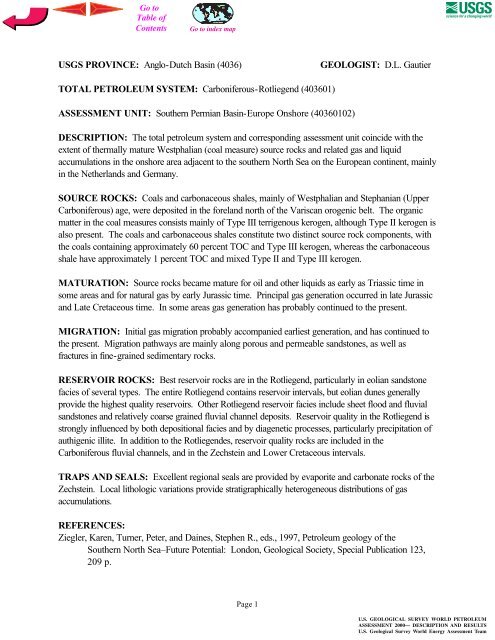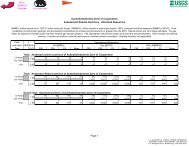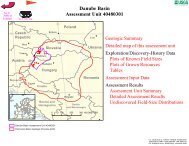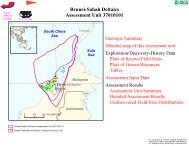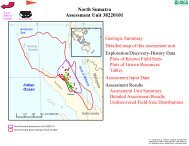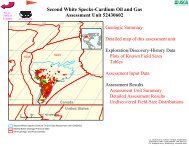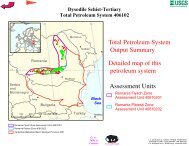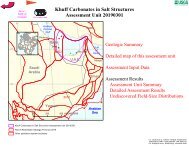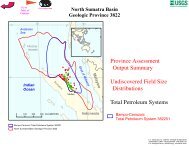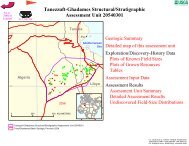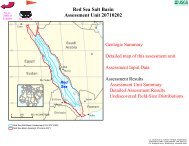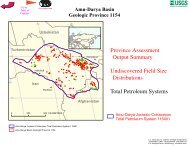Southern Permian Basin-Europe Onshore Assessment Unit 40360102
Southern Permian Basin-Europe Onshore Assessment Unit 40360102
Southern Permian Basin-Europe Onshore Assessment Unit 40360102
You also want an ePaper? Increase the reach of your titles
YUMPU automatically turns print PDFs into web optimized ePapers that Google loves.
USGS PROVINCE: Anglo-Dutch <strong>Basin</strong> (4036)<br />
GEOLOGIST: D.L. Gautier<br />
TOTAL PETROLEUM SYSTEM: Carboniferous-Rotliegend (403601)<br />
ASSESSMENT UNIT: <strong>Southern</strong> <strong>Permian</strong> <strong>Basin</strong>-<strong>Europe</strong> <strong>Onshore</strong> (<strong>40360102</strong>)<br />
DESCRIPTION: The total petroleum system and corresponding assessment unit coincide with the<br />
extent of thermally mature Westphalian (coal measure) source rocks and related gas and liquid<br />
accumulations in the onshore area adjacent to the southern North Sea on the <strong>Europe</strong>an continent, mainly<br />
in the Netherlands and Germany.<br />
SOURCE ROCKS: Coals and carbonaceous shales, mainly of Westphalian and Stephanian (Upper<br />
Carboniferous) age, were deposited in the foreland north of the Variscan orogenic belt. The organic<br />
matter in the coal measures consists mainly of Type III terrigenous kerogen, although Type II kerogen is<br />
also present. The coals and carbonaceous shales constitute two distinct source rock components, with<br />
the coals containing approximately 60 percent TOC and Type III kerogen, whereas the carbonaceous<br />
shale have approximately 1 percent TOC and mixed Type II and Type III kerogen.<br />
MATURATION: Source rocks became mature for oil and other liquids as early as Triassic time in<br />
some areas and for natural gas by early Jurassic time. Principal gas generation occurred in late Jurassic<br />
and Late Cretaceous time. In some areas gas generation has probably continued to the present.<br />
MIGRATION: Initial gas migration probably accompanied earliest generation, and has continued to<br />
the present. Migration pathways are mainly along porous and permeable sandstones, as well as<br />
fractures in fine-grained sedimentary rocks.<br />
RESERVOIR ROCKS: Best reservoir rocks are in the Rotliegend, particularly in eolian sandstone<br />
facies of several types. The entire Rotliegend contains reservoir intervals, but eolian dunes generally<br />
provide the highest quality reservoirs. Other Rotliegend reservoir facies include sheet flood and fluvial<br />
sandstones and relatively coarse grained fluvial channel deposits. Reservoir quality in the Rotliegend is<br />
strongly influenced by both depositional facies and by diagenetic processes, particularly precipitation of<br />
authigenic illite. In addition to the Rotliegendes, reservoir quality rocks are included in the<br />
Carboniferous fluvial channels, and in the Zechstein and Lower Cretaceous intervals.<br />
TRAPS AND SEALS: Excellent regional seals are provided by evaporite and carbonate rocks of the<br />
Zechstein. Local lithologic variations provide stratigraphically heterogeneous distributions of gas<br />
accumulations.<br />
REFERENCES:<br />
Ziegler, Karen, Turner, Peter, and Daines, Stephen R., eds., 1997, Petroleum geology of the<br />
<strong>Southern</strong> North Sea–Future Potential: London, Geological Society, Special Publication 123,<br />
209 p.<br />
Page 1


